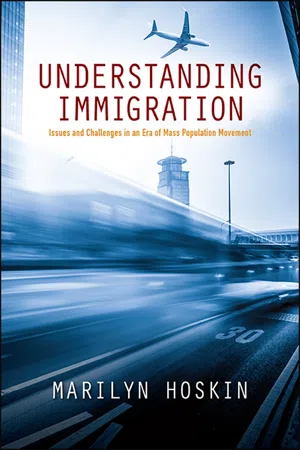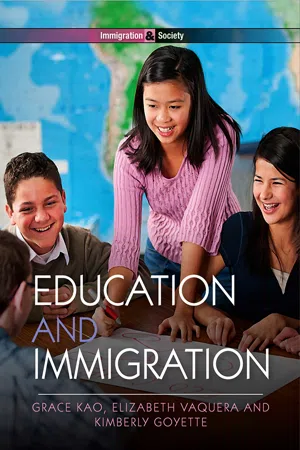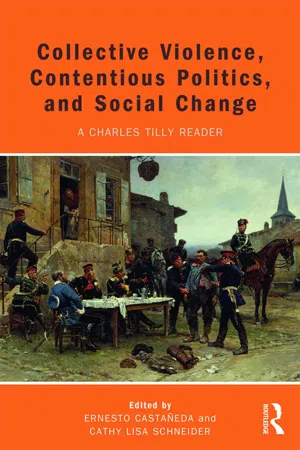History
European Immigration to America
European immigration to America refers to the mass movement of people from Europe to the Americas, particularly during the 19th and early 20th centuries. This migration wave was driven by factors such as economic opportunities, religious freedom, and escape from political turmoil. It significantly shaped the cultural, social, and economic landscape of the United States and other American countries.
Written by Perlego with AI-assistance
Related key terms
7 Key excerpts on "European Immigration to America"
- eBook - ePub
Understanding Immigration
Issues and Challenges in an Era of Mass Population Movement
- Marilyn Hoskin(Author)
- 2017(Publication Date)
- SUNY Press(Publisher)
Finally, the United States cannot escape the perception and reality of capacity rare in the world of advanced nations. Two hundred years of immigration to open territories and experiences with unanticipated newcomers have demonstrated an enviable ability to absorb outsiders. What makes current discussions about legal and illegal immigrants especially difficult is the fact that Americans have historically resisted monitoring any residents. Borders have always been porous and mechanisms to track foreigners minimal or nonexistent, yet those who have entered have historically become part of the fabric of society. If history defines a nation’s comfort level with immigration, the American version has established a foundation for seeing immigrants in ongoing and important roles. As this component of our framework aids understanding national options, it dictates recognition that immigration has consistently strengthened its economy and enriched its culture—even if its population has just as consistently been an initially grudging audience.Economic Factors in American Immigration
In the often heated debates about immigration policies, recent or projected increases in admissions are commonly linked to grim economic forecasts. Communities fear unemployable hordes; workers worry about keeping their jobs; public agencies project hopeless outlooks for schools and health facilities. Casting immigrants as costly to those who admit them is hardly new, but continues to require examination of economic issues over time and circumstance in both the United States and Europe.Basic Economic Drivers of Immigration
During its long history of immigration, the United States has experienced all of the forces defined in classic “push-pull” theories of population movement. In the “push” category are circumstances that have driven mostly desperate people to leave their homelands for uncertain futures. Famines in Europe motivated millions in the mid-nineteenth century; insufficient arable land forced farmers to choose between working in overcrowded cities and hoping to find unclaimed land in the United States. Aiding in the decision to leave was the reality that workers would outnumber jobs in Europe, creating a surplus of labor with no safety net. In the first half of the twentieth century, fascist regimes and two devastating wars created surges of dislocated Europeans who would seek resettlement in any safe environment. Well-educated young people in Asia and Africa facing bleak job prospects moved to pursue opportunities abroad, particularly in the United States, and the specter of poverty and violence drove many to attempt long and dangerous journeys for a chance at a better life. Economically or socially disrupted lives defined literally millions of immigrants. - eBook - ePub
- Grace Kao, Elizabeth Vaquera, Kimberly Goyette(Authors)
- 2013(Publication Date)
- Polity(Publisher)
Throughout the chapter, we underscore how changes in immigration regulations are related to the characteristics of the immigrants arriving to the US. We also describe how immigrant groups were initially positioned within the socioeconomic, ethnic, and racial hierarchy of the US, and how, for some groups, their relative racial status has changed over time. The historical context of immigration in the last 200 years underlies the theoretical shifts among immigration scholars discussed in the previous chapter: from traditional understandings of assimilation that assumed unidirectional upward mobility, to more recent ideas that allow room for downward socioeconomic mobility among immigrants. Throughout the chapter, notice the opposition Americans have had to immigration and their concerns about the “assimilability” of the most recent arrivals time after time. The groups those feelings were directed toward and the regulations that were in place to restrict or prevent their migration to the US have changed over time, however. These shifts in how and which immigrants came to the US as well as the changing context of reception have affected their opportunities to obtain a good education and, consequently, their social mobility over time. We ask the reader to consider: How do US policies toward immigration influence whether immigrants become “American?” How might these policies affect the jobs they get and the places they live? In later chapters, we will ask the reader to consider how the policies that lead to these patterns may influence the educational achievement and attainment of both immigrant adults and the children in immigrant families.The two centuries that are the focus of this chapter can be divided into several distinct eras of immigration. In part, we have characterized these periods by the national-origin and numbers of immigrants. Within these periods, notice the relationship between the racial and ethnic makeup of immigrants and changes in immigration restrictions that support differential treatment of certain immigrant groups. As you read the chapter, refer to figures 3.1 and 3.2 - eBook - ePub
American Civilization
An Introduction
- David Mauk, Alf Tomas Tønnessen, John Oakland(Authors)
- 2021(Publication Date)
- Routledge(Publisher)
Chapter 3 The peopleSettlement and immigration
- Mother of exiles
- Early encounters between Europeans and Native Americans
- The founders
- The first wave: colonial immigration, 1680–1776
- The second wave: the “old” immigrants, 1820–90
- Settlement patterns and nativism
- The third wave: the “new” immigrants, 1890–1930
- A renewed immigration debate and immigration restriction
- Wartime policies and the search for principle in immigration policy
- The fourth wave: 1965 to the present
- Attitudes to immigrants: the contemporary debate
- Exercises
- Further reading
- Websites
Mother of exilesImmigration is a central aspect of US history. It is a major reason that the nation’s total population grew to more than 325 million by 2016. Believing in the American dream, many tens of millions of people have come to live in the US. They thus changed their homelands, America and their family histories forever. They strengthened the nation’s commitment to “the dream” and to its ideal of being a refuge for the poor and oppressed, a nation of nations. Gradually, over the centuries of massive immigration and the struggles of newcomers and Americans to adjust to each other, the view that the nature of the nation was and should be a composite of many national backgrounds, races and cultures gained popular acceptance.This pluralistic view continues to face opposition. In 2016, Donald Trump made his promise to build a Great Southern Wall against immigrants a major part of his presidential campaign. Resistance to pluralism comes from several quarters: from those opposed to the presence of an estimated 11 million undocumented immigrants, those who believe the country is becoming “Latinized” and that newcomers should leave their homeland cultures behind, from people who feel that newcomers take “our” jobs, and those convinced that the latest wave of immigration necessitates a focus on cohesion. - eBook - ePub
Collective Violence, Contentious Politics, and Social Change
A Charles Tilly Reader
- Ernesto Castañeda, Cathy Lisa Schneider(Authors)
- 2017(Publication Date)
- Routledge(Publisher)
Not that the smoothly rational operation of an open, competitive, international labor market characterized by wage differentials accounts for the rhythm and timbre of American immigration. At the very least we need to recognize two facts about that immigration. First, it was and is extraordinarily selective by origin and type of migrant. Second, it usually did not draw on isolated individual decision makers but on clusters of people bound together by acquaintance and common fate. Nor were there clusters mere categories—skilled or unskilled, Jew or Gentile, Greek or Italian. To be sure, individuals did migrate to the United States, and sometimes alone. But they did so as participants in social processes that extended far beyond them. Of course, members of different categories of the European population migrated to the United States (and returned to Europe) at spectacularly different rates. But the categories we ordinarily apply to those differences poorly describe the actual groups that lived and organized transatlantic migration.From the New Deal era to the immediate postwar period, American historians undertook a major revamping of ideas about immigration. Where earlier chroniclers had seen immigrants as foreign elements injected, and ultimately absorbed, into American life, the revisionists portrayed immigration as an indigenous American social process. The academic analysis had political overtones, for it argued against nativism and for the maintenance of equal opportunity. As Oscar Handlin, one of the major revisionists, put it, their approach startedwith the assumption that the entire population of the United States almost from the start was a composite, made up of elements from a multitude of sources. Among these heterogeneous multitudes those who had actually been born in other countries represented only the extreme of a condition that was general to the whole society. The differences between them and the native-born of various sorts, while real, were differences of degree rather than of kind. - eBook - ePub
- Steven J. Gold, Stephanie J. Nawyn(Authors)
- 2019(Publication Date)
- Routledge(Publisher)
In contrast to the Chinese Empire since the High Middle Ages colonization migration has been of minor importance in Europe. Exceptions were the Ottoman and Russian empires. We are especially well informed about the latter, where imperial policies since Catharina the Great opened up vast territories in the south and the east. A conservative estimate is that between 1750 and 1900 some 10 million peasants settled in the Forest heartland and the Steppe regions of European Russia. To some extent the massive population movements in southeastern Europe, in the wake of the crumbling Ottoman Empire might also be subsumed under the heading of colonization. In most cases this involved forced population exchanges between Greece (1922/1923) and the Balkans on the one hand and the new Turkish state on the other. Many of these migrants ended up in cities, but a considerable number involved rural to rural moves, which reshaped the rural landscape in this part of Europe.Other colonization migrations concern Europeans moving outward, especially to the American and Siberian frontiers. Again, this involved in each case at least 10 million migrants, who as emigrants settled in sparsely populated lands where the native population was either killed or marginalized.Moves to the cityDuring the early modern period considerable numbers of Europeans flocked to cities. Their numbers were especially high because of the high urban mortality, which necessitated a constant stream of migrants, as well as the spectacular urbanization in the area that covered northern Italy, southern Germany and the northwest (Belgium, the Netherlands and England). This urbanization process, which intensified and spread in the 19th and 20th centuries, to a large extent due to the permanent settlement of country folk, is often studied and discussed separately from the ‘great migration’ to the Americas. This mental membrane often hides more than it reveals. There are good reasons to consider the Atlantic, including Europe and the Americas, as one migratory space from the mid-19th century onwards. The transportation and communication revolutions in particular expanded the geographical scale of European migrations and brought the Americas, as well as other imperial spaces (especially within the British and French global empires), in direct reach of potential migrants. Moreover, as economic historians have shown, the ‘first round of globalization’ (1820–1914) quickly led to a gradual convergence of wages and created a common space in which the bright lights of the city could be Vienna, Paris, Amsterdam, but also Chicago, Buenos Aires or Toronto. - eBook - ePub
Welcoming the Stranger
Justice, Compassion & Truth in the Immigration Debate
- Matthew Soerens, Jenny Yang, Leith Anderson(Authors)
- 2018(Publication Date)
- IVP(Publisher)
Though there were many groups that faced unjust treatment—Native Americans were not included as citizens, African Americans were enslaved, and women were not allowed to vote—new immigration remained open to all.Among the earliest to arrive in what would become the United States, of course, were men and women from Africa, who were enslaved and taken against their will to the New World. An estimated 645,000 Africans were involuntarily displaced and forced to work as slaves in what is now the United States, with millions more being sent to other parts of the Western Hemisphere.10 It is important to remember this tragic element of our country’s immigrant history, particularly since involuntary migration—now termed human trafficking—continues to be a problem today.The first great European wave: 1820–1860. Throughout American history, immigration levels have ebbed and flowed, depending both on what was happening in the United States and in other parts of the world. As is still often the case, events in the particular country of origin often precipitated large waves of immigration: in the 1840s, for example, a massive famine caused by the failure of the potato crop in Ireland provided the push that many Irish needed to leave their homeland and come to the United States, where farmland was abundant.11 German immigration spiked around the same time, as people fled a government that had stomped out an attempted revolution in 1848, seeking the liberty and democracy offered by the United States.12 These Irish and German immigrants, in particular, created a wave of immigration unlike anything the United States had seen up to this point. Over five million immigrants arrived between 1820 and 1860, about twenty times more than the number of immigrants who had arrived in the previous forty-four years since the nation’s independence.13 By 1860, 13.2 percent of the population of the United States was foreign born, a percentage that would roughly stay the same through the 1920s.14 - eBook - ePub
- Martin Baldwin-Edwards, Martin A. Schain(Authors)
- 2013(Publication Date)
- Routledge(Publisher)
The second process is that of incorporation or integration, a process which has had implications for a whole range of policy areas, but one that has also had an impact on the structure and relations among political institutions. In this process, immigrants are not only the objects of policy, but have become political actors who have had an impact on the process itself. Increasingly the politics of immigration involves conflicts between different visions and models of integration — conflicts that challenge long-accepted models of national identity and the nature of national integration.The dynamics of both processes have been influenced by larger trends in Europe: some of these are historically rooted whilst others have emerged more recently.The Process of Migration
Until the early 1970s, the process of migration developed in the context of the Cold War which prevented migration across the East-West division; a chronic labour shortage in Britain, France and FRG; a relatively poor periphery of Western Europe, particularly in Ireland, Spain, Portugal, Southern Italy, Greece, Yugoslavia and Turkey; and an expanding population along the southern shore of the Mediterranean. The rapid economic expansion of the countries of the European Community attracted workers from the more impoverished periphery, as well as from the former colonies of the major European countries. Italy was able to draw on labour from her own rural south, and for a time continued to export labour to other countries in Europe and as far as the United States, Argentina and Australia.In this context, each labour-importing country developed its own policies and programmes both to attract and to mobilise necessary labour. Policies were constructed to attract and import workers, and to direct them into areas and industries with the greatest need. Through a combination of state and private efforts, a great deal of immigrant labour was imported with little popular reaction, and with little impact on the political system. Until the 1970s, ‘immigration’ was not regarded as a political problem either by political élites or by mass publics (with the major exception of the UK) and there seemed to be a reasonable fit between the needs of labour-exporting countries and those in Europe that were importing labour.
Learn about this page
Index pages curate the most relevant extracts from our library of academic textbooks. They’ve been created using an in-house natural language model (NLM), each adding context and meaning to key research topics.






